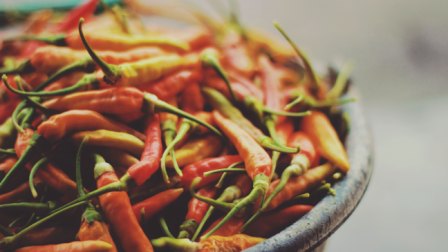
Busy schedules, over indulging, and strenuous summer activities can lead to sore muscles, indigestion and headaches. When searching for pain relief, look no further than your own garden or your local farmer’s market. These five foods fresh from the garden – or pot – are packed with super pain-relieving and anti-inflammatory power.
Mint
Infuse mint into your tea or ice water to refresh and rejuvenate, so you’re ready for more summer fun. Mint also helps relieve headaches and general aches and pain. Grow this vigorous perennial herb in a container so it won’t overtake your other plants. Then at the end of the season, root a few cuttings to start new plants to grow indoors. All you need is a sunny window, quality potting mix and regular watering.
Hot Peppers
Capsaicin, the spicy element in chili, jalapeno, habanero and cayenne peppers, is a great pain-fighting tool and is often used in topical creams to help treat backaches, arthritis and muscle pain. Hot peppers are ready to harvest when they are fully colored. Ask friends to share their harvest or purchase hot peppers at your local farmer’s market if your garden is lacking this plant. Be sure to purchase extra hot peppers to dry and enjoy year-round. Then add these tasty and pain-relieving plants to your garden next summer. Plant them after the soil and air warm, at the same time you plant sweet peppers and tomatoes.
Cherries
Manage muscle pain and inflammation with sour cherries. They are loaded with disease fighting chemicals and antioxidants. Plus, they help fight inflammation and relieve pain. Purchase plenty of cherries to juice, dry and preserve so you can enjoy their health benefits all year long. And consider planting a sour cherry tree in your backyard. Montmorency is the most popular sour cherry tree, needing only 700 hours of air temperatures between 34 and 45 degrees to initiate flowering for fruit development. New hardier dwarf introductions from the University of Saskatchewan can be grown in colder regions including zone 2. Although it takes several years for cherry plants to start producing fruit, you’ll enjoy watching your tree grow into maturity and bear its first crop. Just make sure to cover the plants with netting so the birds don’t eat your harvest.
Ginger
Grow ginger in a pot outdoors or sunny window along side your other indoor plants. Ginger helps reduce inflammation and combat migraines, muscle pain, arthritis and post workout or post-gardening soreness. All this and it helps fight nausea that can be common during a summer filled with barbeques and celebrations. Although it’s a tropical plant, you can find plants or rhizomes (the part you eat) online. Or join other enthusiastic gardeners who have had success rooting the rhizomes they have purchased at the grocery store to start new plants.
Sage
Harvest a few sage leaves, add hot water and brew a bit of sore throat relief. Sage tea has long been used to soothe scratchy and irritated throats and showed positive results in a 2006 clinical trial. Grow this herb in the garden or container. It thrives in a sunny spot with well-drained soil. Harvest leaves as needed throughout the season. Regular harvesting encourages more growth for future harvests. You can remove as much as one third of the plant at one time for preserving.
So next time you’re feeling a bit of pain, look to the garden for a bit of relief. Even the simple act of tending your garden and harvesting produce can elevate your mood, lower your blood pressure and start you on the road to feeling better.
Melinda Myers has written more than 20 gardening books. She hosts the How to Grow Anything DVD series and the nationally syndicated Melinda’s Garden Moment TV and radio segments. You can visit her website at MelindaMyers.com.
 Related Articles & Free Subscription
Related Articles & Free Subscription
Mint is Easy to Grow and Refreshing
Flower Bed Maintenance Keeps Gardens Looking Their Best All Summer Long






Comment here